Sarakatsan Life and Art. 1979
Sarakatsan Life and Art, 1979

Scientific responsible: Konstantinos Kefalas
The exhibition featured aspects of the social life and material culture of the nomadic Sarakatsans. The seven rooms - thematic sections of the exhibition presented the nomadic life of the Sarakatsans, with their movements to and from mountain to lowland grazing, marriage ceremonies, male and female costume (with special reference to the women's aprons or panaoules) and the various occupations of men and women: grazing the flocks, wood-carving, weaving, building their traditional dwellings. A separate section introduced visitors to the main Greek and foreign literature on the life and art of the Sarakatsans.
The material on display included:
Α. Costumes
Male and female costumes - unique examples unparalleled anywhere else in Greece: heavy, handwoven garments made of wool, decorated with characteristic geometrical designs.
Β. Aprons
The Sarakatsan apron was a typical part of a woman's dress. All of the women's skill was devoted to making this garment. The examples from Thrace, square in shape and known aspanaoules, are true works of art.
C. Wood-carving
Wood-carvings are a characteristic example of Sarakatsan art. The most elaborately carved are the distaffs, shepherd's staff and loom weights. The wooden household items of the Sarakatsans are miracles of patience showing an innate sense of moderation in form.
D. Sarakatsan dwellings
The replica of the traditional Sarakatsan hut, which the Sarakatsans constructed themselves along with all its fittings and furnishings, reveals the age-old techniques used in erecting these primitive, makeshift dwellings, built entirely of tree trunks, branches and leaves, without any metal components.
The catalogue with its supplement listing the main literature on the Sarakatsans is unfortunately out of print.

 Follow us
Follow us 



